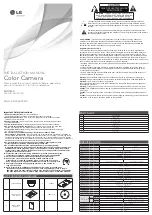
-6-
This thermal imaging camera is designed for
the contactless measurement of surface
temperatures.
The displayed thermal image shows the
temperature distribution of the area captured
by the infrared lens and therefore enables
temperature deviations to be depicted in different
colors.
When used correctly, this makes it possible to
examine areas and objects in a contactless
manner for temperature differences and
discrepancies in order to make components and/
or any weaknesses visible, including:
– Thermal insulation and other types of insulation
(e.g. locating thermal bridges)
– Active heating and hot water pipes (e.g.
underfloor heating) in floors and walls
– Overheated electrical components (e.g. fuses
or terminals)
– Machine parts (e.g. overheating due to faulty
ball bearings)
The tool must not be used for temperature
measurement on persons and animals or for
other medical purposes.
The tool is not suitable for surface temperature
measurement of gases or liquids.
Intended Use
The manufacturer is not responsible
for radio interference caused by
unauthorized modifications to this
equipment. Such modifications could void the
user’s authority to operate the equipment.
This device complies with Part 15 of the FCC
Rules. Operation is subject to the following two
conditions:
1) This device may not cause harmful interfer-
ence, and
2) This device must accept any interference re-
ceived, including interference that may cause
undesired operation.
NOTE! This equipment has been tested and
found to comply with the limits for a Class B
digital devices, pursuant to Part 15 of the FCC
rules. These limits are designed to provide rea-
sonable protection against harmful interference
in a residential installation. This equipment gen-
erates uses and can radiate radio frequency en-
ergy and, if not installed and used in accordance
with the instructions, may cause harmful interfer-
ence to radio communications. However, there
is no guarantee that interference will not occur
in a particular installation. If this equipment does
cause harmful interference to radio or television
reception, which can be determined by turning
the equipment off and on, the user is encouraged
to try to correct the interference by one or more
of the following measures:
• Reorient or relocate the receiving antenna.
• Increase the separation between the equip-
ment and receiver.
• Connect the equipment into an outlet on a cir-
cuit different from that to which the receiver is
connected.
• Consult the dealer or an experienced radio/TV
technician for help.
“Exposure to Radio Frequency (RF) Signals: The
wireless device is a radio transmitter and receiv-
er. It is designed and manufactured not to exceed
the emission limit for exposure to radio frequency
(RF) energy set by the Ministry of Health (Cana-
da), Safety Code 6. These limits are part of com-
prehensive guidelines and established permitted
levels of RF energy for the general population.
FCC Caution
This device complies with Industry Canada’s
licence-exempt RSSs. Operation is subject to the
following two conditions:
(1) This device may not cause interference; and
(2) This device must accept any interference,
including interference that may cause undesired
operation of the device.
Industry Canada (IC)







































